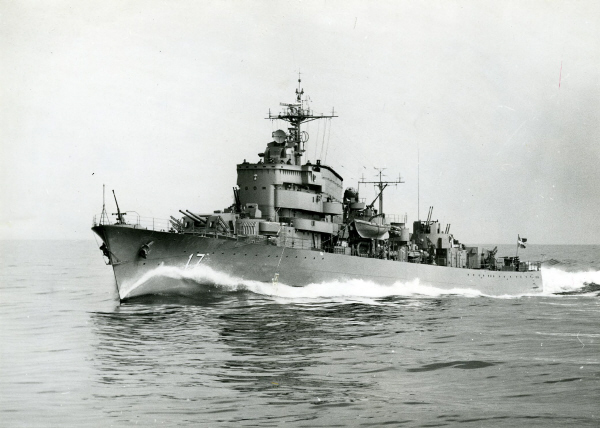
Two Swedish fleet destroyers Launched in 1945-46 and completed in 1947-48. Much larger, inspired by the USN Gearing class. Technically both destroyers has been completed in 1947 and entered service just when the cold war started in 1948, but both were wartime designs strongly influenced by US flush-deck destroyer design.
Both destroyers were laid down at Kockums and Karlskrona respectively in 1943, launched respectively in December 1945 and November 1946 and completed on 5.12.1947 and 31.1.1948 respectively. They were small by USN standard, at just 1,800 tonnes. They were not supremely fast either at 35 knots but won in versatility. In addition to dual purpose semi-automated fast-firing dual purpose 120 mm guns (80° elevation) plus six torpedo tubes and reloads, and their AA was impressive with up to seven 40 mm Bofors (HMS Uppland), eight 25 mm guns. For ASW warfare, they had the usual DC and DCTs, plus a single 357 mm Bofors quadruple rocket launcher.
They could act as minelayer as well, carrying 60. Their radius of action was 2500 nm at 20 knots, carrying 300 tonnes of oil. Crew was 210. Their machinery was protected as well as vital parts in the superstructures by additional armor plating. They were modernized, for the first Öland in 1949, 1953, 1960 and 1969 and for the second, Uppland in 1953 and 1963. Bu by 1974 they were reclassed as frigates.
They were the largest destroyers built in Sweden, and its first and last missile destroyers. Designed first for anti-ship warfare, they possessed anti-ship missiles before any one else in Europe, at the exception of the Soviet fleet.
Development
During World War Two, development moved towards larger destroyers. Those destroyers of the Great Powers had grown to 1,500–2,000 tons standard, used in conjunction with flotilla leaders that were in the 3,000–4,000 tons range. The Riksdag was convinced by the Swedish naval staff in 1942, that the Swedish fleet need to mix large flotilla leaders with more conventional vessels the same way. As flotilla leaders, it was decided in the end to design the Tre Kronor class light cruisers would be used, and four new destroyers would be built to be led by those, completed with older ships.
Of the four planned destroyers, only two were built at least of the first design. After studying foreign destroyer designs, drawings and specifications for these new destroyer class were prepared, and quotations obtained from several shipyards. Those in Gothenburg were not considered as they obtained these new HMS Tre Kronor and HMS Göta Lejon already. The lowest price for the construction of destroyers was proposed by the Oskarshamn shipyard. However, the Navy Administration assessed this offer unreasonable and unfeasible, and instead signed a contract with Kockums, Malmö for a single destroyer, and with Karlskronavarvet for the other.
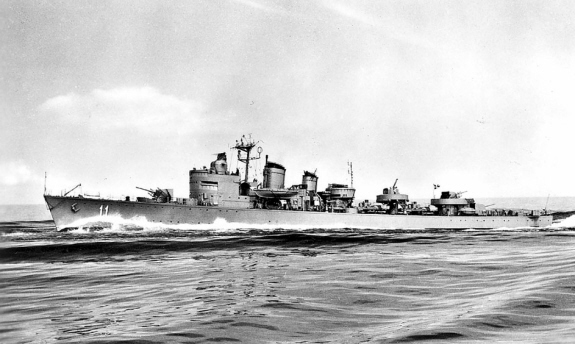
The previous Visby class destroyers
To be clear, the new destroyers were a clear departure from previous designs, with perhaps only the flush deck hull as a common point. The interwar lineage of Swedish destroyers led to quite distinctive ships, unlike these seen anywhere else and apart some Italian influence (Psilander) the Ehrenskjöld, Klas Horn, Göteborg classes evolved as a quite unique design with some loose influence from the WWI Clemson/Gleaves. The last Swedish Destroyers developed to that point were the wartime Visby Class launched in 1942. Compared to standards at the time, armed with five main guns they had only three and six torpedo tubes when the new norm was two quadruple ones (so eight). Only “stock” AA was good with Bofors 40 and 20mm guns. They were small also at 1135 tons.
For the new destroyers it was decided to adopt twin turrets to have at least four main guns, and this implied to scale up the design, which reached 1880 tonnes standard, quite a stretch.
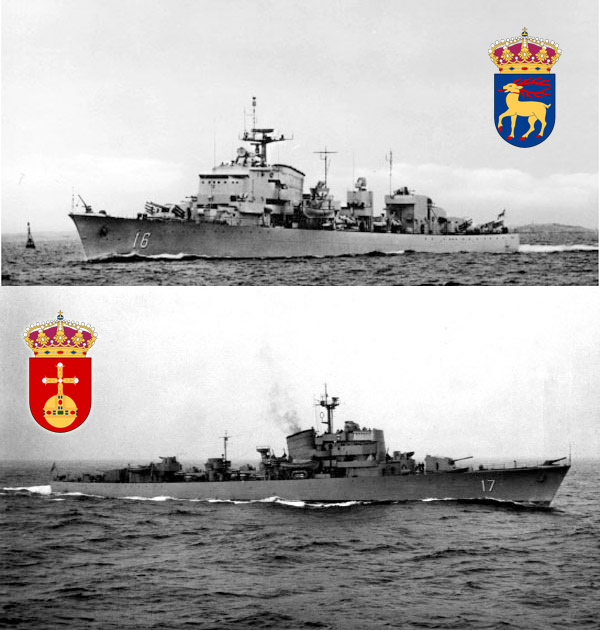
Design of the class
Hull and general design
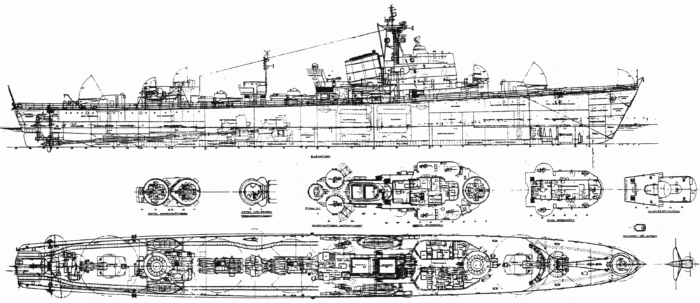
The ships were 111.8 meters long (107 meters between perpendiculars) with a double hull all along its lenght plus compartimentation below the waterline to mitigate flooding and hull damage. During the planning, it was considered to design the hull with a forecastle but this was eventually ruled out. The hulls were fully welded, with the exception of the armor plating around the engine spaces, all riveted. Due to her size, beam ratio (11.2 meters wide, 1/10) and hull shape (3.40 meters draft instead of 3.80 meters on the Visby class), the Öland class was much more stable than previous Swedish destroyer types. During design phase, it was even feared that they would become too stable and thus be less agile overall or with extreme moves when pushed hard. However, the great weight from the armor layout meant that this was not the case. Imperial: 364 f x 37 ft x 11 ft.
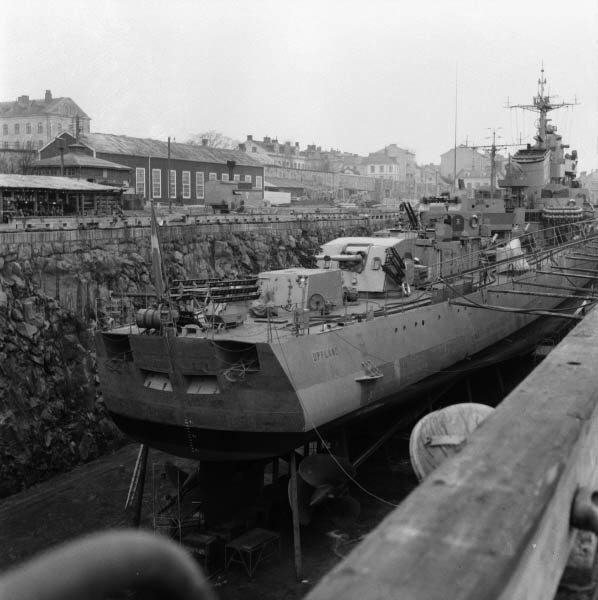
The peculiar transom stern of the class, with the two outer openings were for mines and the two inner ones below for depth charges.
As for the hull design, it followed previous trends, with a pronounced, sharp clipper bow and some generous flare, fine entry lines, continuous flush deck with the central section amidship entirely filled up to the weather deck by the machinery space, boilers and then turbines, and living quarters and a single utility deck aft, two utility decks forward. For the structure design, it was not like previous Visby. Instead of the traditional rounded bridge, it was opted for a narrow, tall three stages bridge, with both an enclosed and open bridhe above. The enclosed bridge had rather limited visbility through a few portholes. There was a single, short, and almost stubby mainmast aft of the bridge with a platform to support antenna and a radar when upgraded in the 1950s.
The wings of the bridge extended to the hull’s beam and supported 20 mm AA mounts.
Another distinctive point was a the single passive funnel in which the boiler’s exhausts vented out just above with limited truncation. There was a tall platform for two light projectors aft of the funnel and stubby mainmast on the radio room between TT banks. The latter had a radiodetection mast with a HFDF antenna. The reduced quartederdeck structure supported the aft twin AA Bofors. The thord one was forward of the bridge in a superfiring pair above ‘A’ turret.
Powerplant
The öland class had two shafts driven by two sets De Laval geared steam turbines, fed by two Penhoët boilers. This was rated for a total of 44,000 shp, for a top speed of 35 knots. To compare, the Visby class had 36,000 hp for 39 knots. So the beefier öland were slower albeir having a large power, due to the larger dimensions and tonnage. They carried also 300 tons of fuel oil for a range of 2,500 nautical miles at 20 knots, twice as much as the Visby class (150t).
Armament
The centerpiece of the design was a pair of 67 tons dual purpose twin turrets developed specially for 12 cm/50 Model 1942 Bofors Cockums, which were a brand new semi-automatic design with dependent barrels (no separate elevation to 80 degrees) and a new lightly armoured turret that supported rockets on its side. It was also used on the next Östergötland classes and the design process started in 1942 but only was completed in 1945. Little data has been published so far on them. It is known they had a about 236.2 in (6.000 m) barrel, were capable 20 rounds per minute, fired a separate HE round weighting 52 lbs. (23.5 kg) without propellant, at 2,790 fps (850 mps).
12 cm/50 (4.7″) M/44 Model 1942
⚙ specifications Bofors 12 cm/50 |
|
| Weight | 67 tons full turret |
| Barrel length | 6 meters (236 inches) |
| Elevation/Traverse | -10°/+80°, +150° either side |
| Loading system | Semi Auto, separate rounds |
| Muzzle velocity | 850 mps |
| Range | 19,100 m/45°, 9,000 m ceiling |
| Guidance | Optical |
| Crew | Unknown |
| Round | HE 23.5 kgs |
| Rate of Fire | 20 rpm |
Typ 14 Torpedoes
Like the Visby and previous class, both destroyers had the same two triple torpedo tubes banks. Both were located aft amidships above the steamturbines. They had a isimilar manual control built in “pilot house” above similar to US TT banks, and the type is unknown, possibly the Typ 14 (Torped 14) on which little info exists.
During the interwar period, an electric torpedo was also experimented with for the first time. In Sweden, these began to be manufactured in 1928 and had batteries from Tudor, several different types were produced during the 1930s. The torpedoes were named UE1-UE6.
During the mid-1950s, another propulsion principle was developed. A torpedo powered by hydrogen peroxide and in 1960 the first test firing was done, Torped type 61.
During the Second World War, it became clear that the method of firing the torpedo straight at the target became increasingly difficult as the ships’ increased speed and better opportunity for evasive maneuvers. The experiments to get torpedoes that could be steered were started. In Sweden, a patent was issued to control via wire and radio from aircraft that was purchased for the navy in 1946. However, the system was not completely reliable with radio waves that did not work satisfactorily under water. During the mid-1950s, the focus was instead on wire control only. Through the wire, the direction of the torpedo could be changed if necessary.
In the post-war years the Royal Swedish Navy developed a conventional straight-running heavy weight torpedo as the Tp (Torpedo) 14 for surface ships and the production version, Tp 141, was followed by the wire-guided Tp 142. For submarine use there was the Tp 27, introduced in 1960 as the Tp 271 and followed by the Tp 272. In 1960, Sweden acquired from the United Kingdom details of High-Test Peroxide (HTP) designs for torpedoes developed from the Mark 12 (Fancy SR) which was abandoned in 1959. Although the British had considerable problems with HTP the Swedes did not and the HTP technology was incorporated into the Tp 61 family of anti-surface vessel torpedoes of which the first version appeared in 1966 as the wire-guided Tp 611. Versions of this weapon, which appeared later, were the Tp 612 (and a derivative of the Tp 618) then the Tp 613 and its export version the Tp 617. In the late 1980’s, FFV (later Bofors Underwater Systems then Swedish Ordnance and now Bofors) began to develop the dual-purpose heavyweight Torpedo 2000). The weapon which will be designated Tp 62, was scheduled to enter service circa 1995, but the contract was not signed until December 17th 1997. Deliveries were to begin in early 2000. A tropicalised export version was designated Tp 96 but was renamed Torpedo 2000.
AA armament
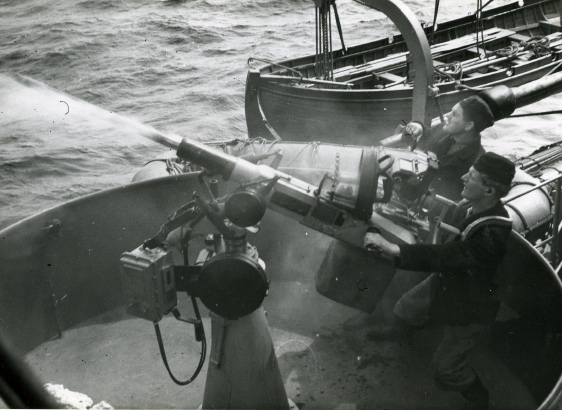
20mm Bofors apjäs M/40 in fire practice on öland
The two ships diverged on that point and in sources. Öland for conways had three twin 40mm/60 Bofors M36, and eight single 20mm/66 M40 when Uppland had seven single 40mm/60 M36 Bofors and the same 20mm/66 M40.
The Bofors fired an AB 40 mm L/60 HE-T weighting 2.05 lbs. (0.93 kg) full, complete round 17.60 in (44.7 cm) and about 0.661 lbs. (0.300 kg) propellant for the HE 4.63 lbs. (2.1 kg) which carried 0.150 lbs. (0.068 kg) TNT for the HE-T 7a.
Muzzle velocity was 2,789 fps (850 mps), with a barrel life between 9,600 and 10,000 Rounds. Bofors produced 11 Naval guns for the Swedish Royal Navy, 61 for export prewar and in wartime 320+ guns for the Swedish Royal Navy alone, 38 postwar, production ended in 1954. Some of the twin water-cooled mounting had integral 1.25 m or 2.0 m Hazemeyer rangefinders.
As for the 20mm/66 M40, they were Bofors’s answer to Oerlikon but both had similar German roots. The automatkanon m/40 was basically a scaled down version of the 25 mm found on the Tre Kronor class cruisers. These single mounts weighted 313 kg and fired a 20×145R 0.29-0.3 kg round at 815-845 m/s and 360 rpm, max range 5 km. Unlike the drum or belt-fed 20 mm/70 Oerlikon they were reloaded by 25 round magazine.
It seems however confusion in dates let to believe this difference, whereas it was a later upgrade. Indeed photos shows the same three twin mounts on both ships, and later both had instead seven 40 mm (1.6 in) guns in single water cooled and power operated Hazemeyer stabilized mounts. The former twin power operated mount had air cooled guns and there was a single hand-worked mount at the bow. The Twin mountings were protected by splinter shields as well.
ASW
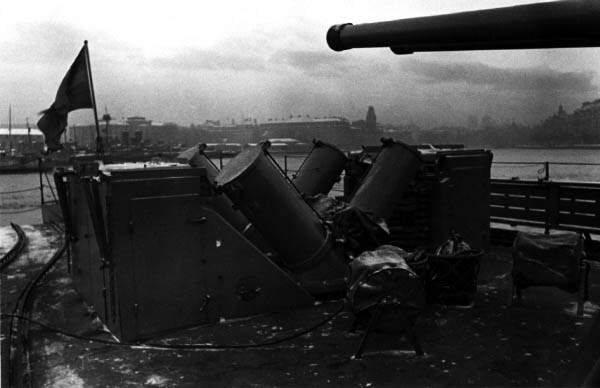
At first these ships were equipped with a typical WW2 suite, two depht charge racks aft dropped from inside the transom stern’s inner chutes, and a pair of depth charge throwers, in a central projector arrangement (see photo).
When modernized, these ships gained a single Bofors 375 mm ASW rocket launcher. They also had rails on the aft deck for 60 mines. They were not dropped from the stern deck, but went into special chutes underdeck to be dropped lower and avoid the adverse effect of the transom stern’s turbulences.
The turrets carried rockets flares, three launch rails for rocket flares on each side.
Sensors and Modernization
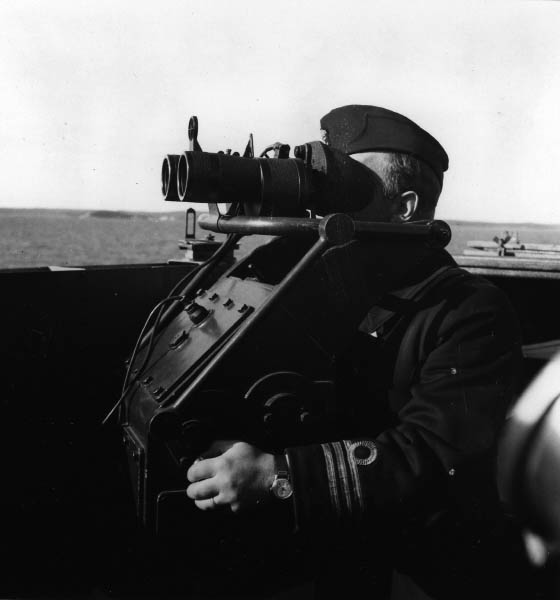
As completed, their electronics suite is unknown. They had radio detection as shown in photo, but no visible radar. In 1949 Öland swapped its twin 40mm/60 for seven 40mm/60 M36 in the same mount as her sister. Both would receive radars (unknown type) in 1953-1954.
In 1959 Öland and in 1963 her sister Uppland had all her Bofors removed as well as the 20 mm for eight single 40mm/70 M48 aradra guided and fully stabilized. In addition the forward mount was swapped for a triple 305 mm Squid M51 ASWRL and the new radar suite includied the Saturn and two M45 fire control radars for their main guns.
In 1974 both vessels were re-rated as frigates, before being stricken in 1978.
⚙ specifications |
|
| Displacement | 1880t standard, 2250t fully loaded |
| Dimensions | 112 x 11.2 x 3.40 meters |
| Propulsion | 2 sets de Laval geared steam turbines, 2 Penhoët boilers, 44,000 shp |
| Speed | 35 knots |
| Range | 300t oil, 2500 nm/20 kts |
| Armament | 2×2 120mm/45 M44, 3×2 40mm/60 M36 or 7x 40mm, 8x 20ll/66 M40, 2×3 533mm TT, 2 DCT, 2 DCR, 40 mines |
| Sensors | Sonar |
| Crew | 210 |
Career of the öland class
 HMS Öland
HMS Öland
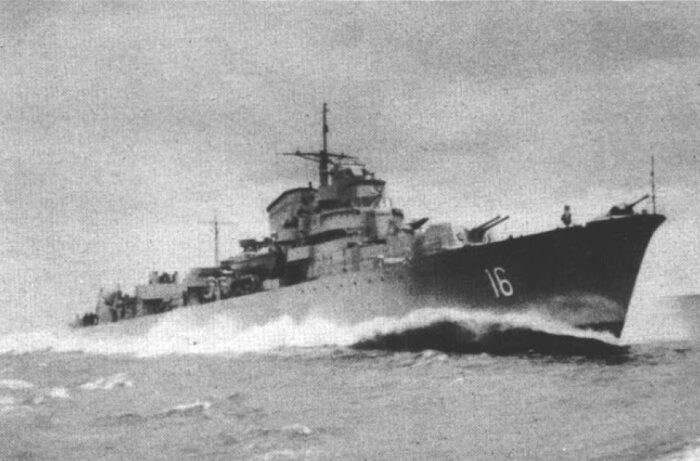
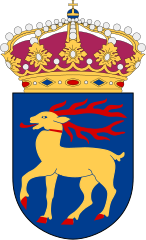 Öland was ordered on 1 July 1943 from Kockums Yard, laid down at Malmö, Launched on 15 December 1945 by Per Albin Hansson and commissioned on 5 December 1947. She took place in one of the two flotillas each led bt a Tre Kronor-class alonsgide two more Visby class destroyers.
Öland was ordered on 1 July 1943 from Kockums Yard, laid down at Malmö, Launched on 15 December 1945 by Per Albin Hansson and commissioned on 5 December 1947. She took place in one of the two flotillas each led bt a Tre Kronor-class alonsgide two more Visby class destroyers.
öland had upgrades in 1949, 1953, 1960 and 1969 and in the 1960 modernisation her displacement rose to 2,000 tonnes (2,000 long tons; 2,200 short tons), her bridge was rebuilt, her depth charge thrower was replaced aft by a Squid 12 inches anti-submarine mortar and the anti-aircraft armament upgraded with stabilized mounts and radar guidance. The 40-mm mount nearest to the jackstaff was removed. In 1964, the 20 mm guns were removed and a good Radar fitted. In 1974 Öland received the Thomson-CSF Saturn S band long range radar as well as a navigation set plus two Hollandse Signaalapparaten M45 fire-control radars while being reclassified as a frigate.
In 1972, the Riksdag wanted to reform the fleet, retire cruisers and destroyers of the postwar generation and replaced these by smaller and nimbleer fast attack craft so she was decommissioned and stricken by 1 July 1978, later broken up.
 HMS Uppland
HMS Uppland
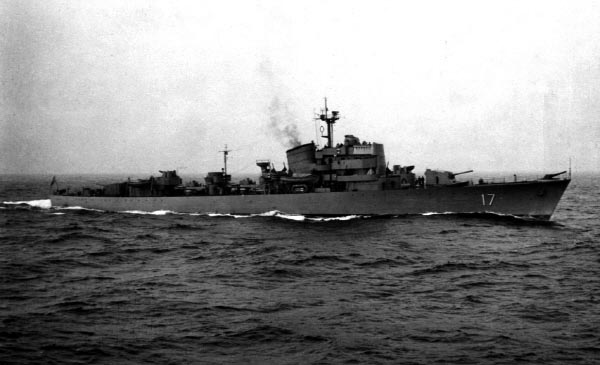
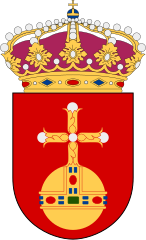 Uppland was ordered on 26 November 1943, laid down at the Naval Yard at Karlskrona afterwards, launched on 15 November 1946, commissioned on 31 January 1948. She joined ther formation led by one of the Tre Kronor-class, likely HMS Göta Lejon. The öland were later superseded by better destroyers of the östergotland class.
Uppland was ordered on 26 November 1943, laid down at the Naval Yard at Karlskrona afterwards, launched on 15 November 1946, commissioned on 31 January 1948. She joined ther formation led by one of the Tre Kronor-class, likely HMS Göta Lejon. The öland were later superseded by better destroyers of the östergotland class.
Uppland received upgrades in 1954 and 1963 and in the latter she received a new bridge and a helideck aft. The light anti-aircraft guns was also removed in 1964. In 1974, she was reclassified as a frigate but she was decommissioned and stricken not longer after on 1 July 1978. She left Lysekil on 10 January 1981 for Gijón in Spain to be broken up.
Read More/Src
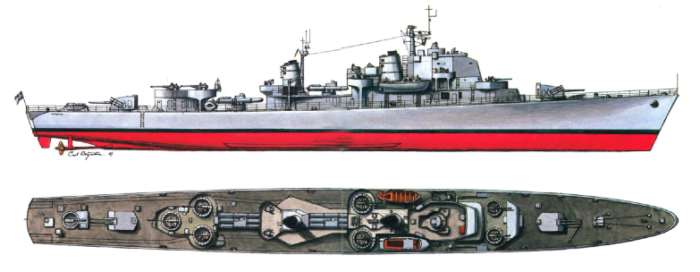
Profile from the book linked below, on fredsbaskerforlaget.se
Books
Conways all the world’s fighting ships 1922-46 p.373 and 1947-95.
Borgenstam, Curt; Insulander, Per; Kaudern, Gösta (1989), Jagare: med Svenska flottans jagare under 80 år. Marinlitteratur
von Hofsten, Gustav; Waernberg, Jan; Ohlsson, Curt S. (2003), Örlogsfartyg: svenska maskindrivna fartyg under tretungad flagg, Svenskt militärhistoriskt bibl.
Whitley, M. J. (2000). Destroyers of World War Two: An International Encyclopedia. London: Cassell & Co. ISBN 1-85409-521-8.
Borgenstam, Curt; Insulander, Per; Kaudern, Gösta (1989), Jagare : med svenska flottans jagare under 80 år (2:a), Västra Frölunda CB Marinlitteratur
von Hofsten, Gustav; Waernberg, Jan (2003), Örlogsfartyg: Svenska maskindrivna fartyg under tretungad flagg (1:a), Svenskt Militärhistoriskt Bibliotek
fredsbaskerforlaget.se swedish book on these destroyers
Links
navypedia.org
on facebook.com
main guns on navweaps.com
on sv.wikipedia.org/
on digitaltmuseum.se/
blm.kulturhotell.se/
tugboatlars.se/Jagare.htm
quarry.nildram.co.uk/Bofors.htm
digitaltmuseum.se/ torpedens-historia-i-sverige
commons.wikimedia.org/ uppland
commons.wikimedia.org/ öland
video wow legends
Model Kits
None found

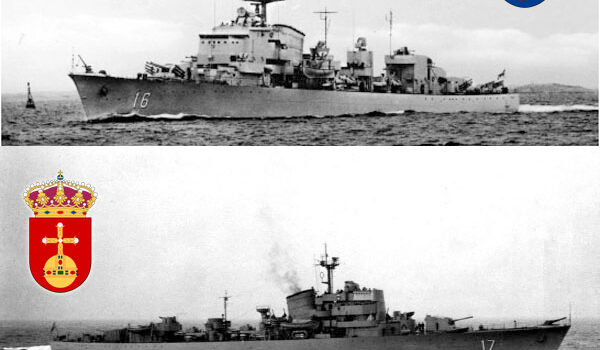

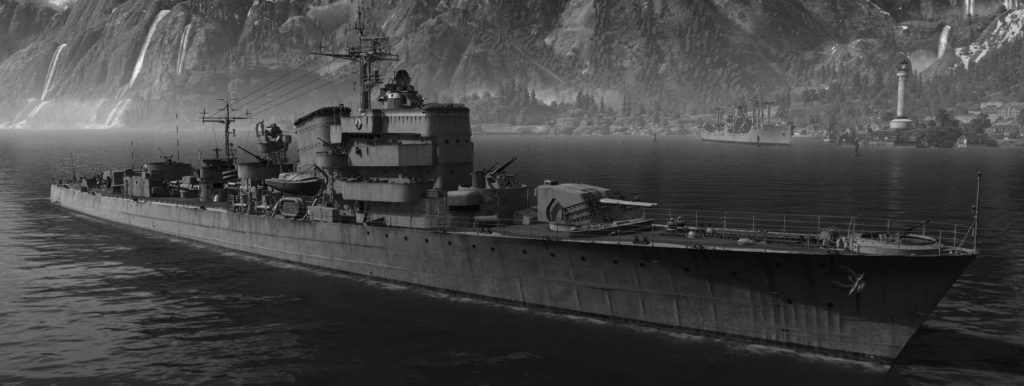

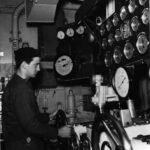
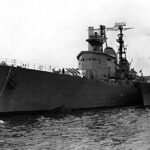
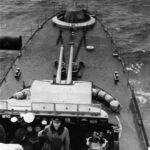
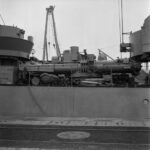
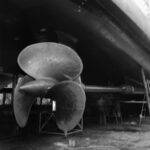
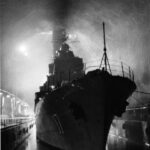
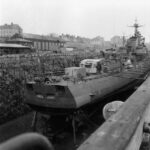
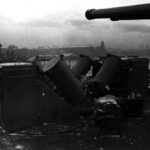
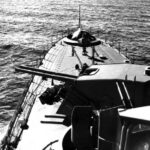
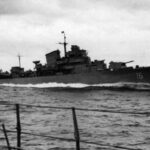
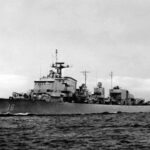
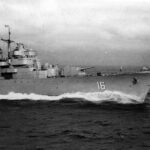
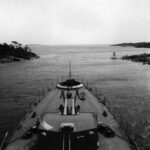
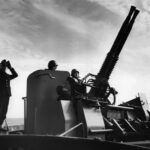
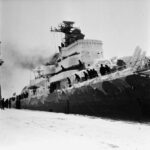
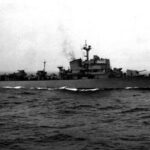
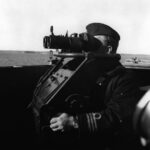
 Latest Facebook Entry -
Latest Facebook Entry -  X(Tweeter) Naval Encyclopedia's deck archive
X(Tweeter) Naval Encyclopedia's deck archive Instagram (@navalencyc)
Instagram (@navalencyc)





 French Navy
French Navy Royal Navy
Royal Navy Russian Navy
Russian Navy Armada Espanola
Armada Espanola Austrian Navy
Austrian Navy K.u.K. Kriegsmarine
K.u.K. Kriegsmarine Dansk Marine
Dansk Marine Nautiko Hellenon
Nautiko Hellenon Koninklije Marine 1870
Koninklije Marine 1870 Marinha do Brasil
Marinha do Brasil Osmanlı Donanması
Osmanlı Donanması Marina Do Peru
Marina Do Peru Marinha do Portugal
Marinha do Portugal Regia Marina 1870
Regia Marina 1870 Nihhon Kaigun 1870
Nihhon Kaigun 1870 Preußische Marine 1870
Preußische Marine 1870 Russkiy Flot 1870
Russkiy Flot 1870 Svenska marinen
Svenska marinen Søværnet
Søværnet Union Navy
Union Navy Confederate Navy
Confederate Navy Armada de Argentina
Armada de Argentina Imperial Chinese Navy
Imperial Chinese Navy Marinha do Portugal
Marinha do Portugal Mexico
Mexico Kaiserliche Marine
Kaiserliche Marine 1898 US Navy
1898 US Navy Sovietskiy Flot
Sovietskiy Flot Royal Canadian Navy
Royal Canadian Navy Royal Australian Navy
Royal Australian Navy RNZN Fleet
RNZN Fleet Chinese Navy 1937
Chinese Navy 1937 Kriegsmarine
Kriegsmarine Chilean Navy
Chilean Navy Danish Navy
Danish Navy Finnish Navy
Finnish Navy Hellenic Navy
Hellenic Navy Polish Navy
Polish Navy Romanian Navy
Romanian Navy Turkish Navy
Turkish Navy Royal Yugoslav Navy
Royal Yugoslav Navy Royal Thai Navy
Royal Thai Navy Minor Navies
Minor Navies Albania
Albania Austria
Austria Belgium
Belgium Columbia
Columbia Costa Rica
Costa Rica Cuba
Cuba Czechoslovakia
Czechoslovakia Dominican Republic
Dominican Republic Haiti
Haiti Hungary
Hungary Honduras
Honduras Estonia
Estonia Iceland
Iceland Eire
Eire Equador
Equador Iran
Iran Iraq
Iraq Latvia
Latvia Liberia
Liberia Lithuania
Lithuania Mandchukuo
Mandchukuo Morocco
Morocco Nicaragua
Nicaragua Persia
Persia San Salvador
San Salvador Sarawak
Sarawak Uruguay
Uruguay Venezuela
Venezuela Zanzibar
Zanzibar Warsaw Pact Navies
Warsaw Pact Navies Bulgaria
Bulgaria Hungary
Hungary

 Bundesmarine
Bundesmarine Dutch Navy
Dutch Navy Hellenic Navy
Hellenic Navy Marina Militare
Marina Militare Yugoslav Navy
Yugoslav Navy Chinese Navy
Chinese Navy Indian Navy
Indian Navy Indonesian Navy
Indonesian Navy JMSDF
JMSDF North Korean Navy
North Korean Navy Pakistani Navy
Pakistani Navy Philippines Navy
Philippines Navy ROKN
ROKN Rep. of Singapore Navy
Rep. of Singapore Navy Taiwanese Navy
Taiwanese Navy IDF Navy
IDF Navy Saudi Navy
Saudi Navy Royal New Zealand Navy
Royal New Zealand Navy Egyptian Navy
Egyptian Navy South African Navy
South African Navy






























 Ukrainian Navy
Ukrainian Navy dbodesign
dbodesign